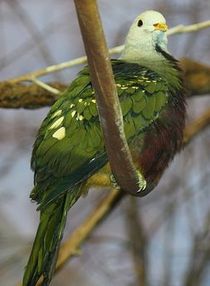Wompoo Fruit-Dove
The Wompoo fruit-dove , also known as magnificent fruit-dove or purple-breasted fruit-dove, is the largest of fruit-doves native to New Guinea and Australia.

The Wompoo Fruit-Dove is classified as Least Concern. Does not qualify for a more at risk category. Widespread and abundant taxa are included in this category.
The Wompoo fruit-dove can be seen in large flocks where food is abundant. The birds feed off fruit-bearing trees in rainforests such as figs. They also occasionally eat insects. They can eat large fruits whole and are able to acrobatically collect fruit of trees and vines. They do not like to travel long distances, preferring to stay in their local area and make use of whatever fruit are in season. More
The Wompoo Fruit-dove can be seen in large flocks where food is abundant. Their call sounds like ‘wollack-wa-hoo’ and often sounds very human. Breeding times will vary according to weather conditions. The nest is sturdily constructed from forked twigs not high from the ground. Both genders help in the construction of the nest. One white egg is laid and the parents share the incubation and care of the chick. More
The Wompoo Fruit-Dove is a big rainforest pigeon. It has a green back, yellow belly, grey head and purple throat and breast. It feeds on fruit in the tops of trees. For such a big bird it builds a tiny nest of twigs for its one white egg. The seeds in the fruit eaten by the Wompoo Fruit-Dove are spread a long way in the dove's droppings so more fruit trees can grow. More
In Australia the Wompoo Fruit-Dove is a common resident of rainforests. * Despite its colourful plumage (of purples, greens, yellows, and blues) it can be difficult to observe in the rainforest canopy. However, it flies noisily and has loud calls. More
priority actions to help recover the Wompoo Fruit-dove in New South Wales. What needs to be done to recover this species? - * Plant locally-occurring fruit-bearing trees and shrubs. * Protect remnant rainforest patches during burning-off activities. * Retain forested corridors that link east to west migration routes. * Encourage and initiate weed control programs. * Protect known and potential food trees. More
The Wompoo fruit-dove is the largest of thefruit doves native to New Guinea and Australia. Physical Description The fruit-doves measure up to 18 in length but are larger in southern regions. It has purple plumage around its neck, chest and upper belly. Its lower belly is yellow with green under-parts. The sexes look similar and the young have a duller and greener plumage compared to adults. More
Wompoo Fruit-Dove at nest. Wompoo Fruit-Dove at nest. More
The Wompoo Fruit-Dove is the largest fruit-dove in Australia. It is often hard to see in the dense foliage of the rainforest despite its brilliant green back, plum breast and curving yellow line across its wings. It weaves its way through the tall rainforest canopy, never coming to the ground. The name comes from its call, which includes a "wompoo" that can be heard up to one kilometre away. More
Wompoo Fruit-Doves recorded 7am, 9th September 2008 at Finch Hatton Gorge, inland from Mackay, Queensland. * * Artist: Paul Jacobson * Title: Wompoo Fruit-Dove * Album: Finch Hatton Gorge * Year: 2008 * Length: 4:03 minutes (5. More
The Wompoo Fruit-Dove is identified by its large size, rich purple throat, chest and upper belly, and yellow lower belly. It has mostly green underparts, with a paler grey head and a conspicuous yellow wing-bar. It is perhaps the most beautiful of all the doves found in Australia, and both sexes are similar in plumage. Birds from the north are smaller (35 - 45 cm) than those in the south (up to 50 cm). More
The Wompoo Fruit-Dove in the photo below hatched its egg and the nestling fledged successfully. During November the numbers of Wandering Whistling Ducks steadily increased to at least 50. It was pleasing to see that they were able to find plenty of food in the new wetland. However, a storm last Monday diminished their numbers to 9 and the following day there wasn’t one to be seen. More

Original source: Ltshears
Author: Ltshears
Permission: Some rights reserved
Family : Columbidae
Genus : Ptilinopus
Species : magnificus
Authority : (Temminck, 1821)
